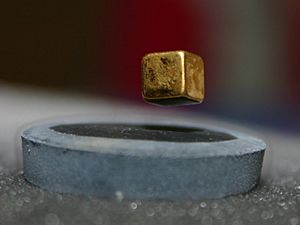Meissner effect facts for kids

The Meissner effect is when a magnetic field is pushed out of a superconductor when it becomes superconducting. If you were to put a superconductor in the field of a big magnet and you looked just inside the superconductor, you would see that the magnetic field was much smaller than it was outside. The deeper in you looked, the closer it would be to zero. This is one of the ways that superconductors are not the same as perfect conductors, which do let magnetic fields pass through them.
The effect was discovered by Walter Meissner and Robert Ochsenfeld in 1933. They saw that because the magnetic field cannot go through the superconductor, the field right outside the superconductor becomes stronger.
One example of the Meissner effect is a magnet levitating above a superconducting plate cooled by liquid nitrogen. In order to stop the magnetic field from going into the superconductor, the superconductor acts like a magnet pointing the opposite direction. This repels the real magnet and stops it from coming any closer.
Images for kids
-
A tin cylinder—in a Dewar flask filled with liquid helium—has been placed between the poles of an electromagnet. The magnetic field is about 8 millitesla (80 G).
See also
 In Spanish: Efecto Meissner para niños
In Spanish: Efecto Meissner para niños




